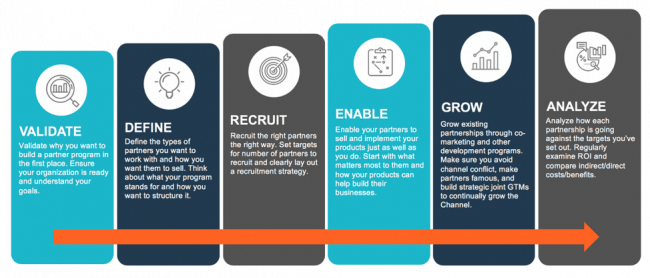
The Journey to Building a Successful Partner Program for Your Software Business – Step 5 of 6

Step 5: Grow

Once you’ve established your foundational partnerships, it’s important that you have the right structure in place to enable your joint business to grow and prosper. The worst scenario is that you’ve invested all this time and energy intro recruiting and getting a few wins under your belt only to let the partnership go stale. Give your partners the tools, incentives, and frameworks they need to continually expand the pie.
The potential is boundless if you give Step 5: Grow the attention it deserves. Read on for some tips on how to continually grow the partnerships you’ve worked so hard to stand up – you’ve built the partnership house, now it’s time to furnish it.
Sales Tactics
Getting more joint sales in the door is the number one goal, right? See some tactics below to do so.
- Partner Performance Scorecards: This sounds simple, but ensuring that you are not only evaluating the attractiveness of a partner during the recruitment stage, but also the continued productivity after the partner is onboarded is critical. Consider scorecards for existing partners across the below criteria:
- Sourced bookings
- Influenced/Touched business
- Registered deal flow
- Pipeline health and predictability
- Sales expertise/Ability to sell confidently
- Technical expertise and delivery
- Joint marketing contribution
- Geographical coverage
- Industry/Vertical coverage
- Quality of delivery
- Overall customer satisfaction
- Communication & Responsiveness cadence
- Target Account Planning: This one is paramount. In a co-sell situation, if you aren’t taking the time to sit down with your partner stakeholders and your direct sales team to map out the target accounts you’re going after, then you are never going to strategically grow your businesses together. Ideally, you should be mapping out the accounts that you can bring your partner into, the accounts your partner can bring you into, and the net new accounts you are going after together. Your joint value messaging should also align to the target market you are going after together. Even in a reseller or ISV situation, you should still be working with your partner stakeholders to map out your unique ‘white space’ from a target account standpoint. Which vertical or horizontal niche markets are your joint ‘sweet spot’?
- Joint Dashboards: Your key partnerships should all be operating on a shared dashboard that lists your key accounts, status of those accounts, and of course pipeline/bookings KPIs and target milestones (e.g., number of certified developers). Creating the right reporting structure with strategic partners is critical to generating accountability and building healthy and predictable pipe. You can do this through PRM software, or start out with manual joint spreadsheets. Ultimately, the goal should always be to give your partners real-time visibility into shared business. The right data and guidance with the right partners at the right time is a powerful mix for growth. To get started, follow the below 4 steps:
- Advance plan quarterly and annual planning sessions (conduct in person if possible)
- Establish clear targets, timelines, and owners
- Set regular check-in cadence with key partner stakeholders
- Define a set agenda for each check-in meeting to ensure productivity
Consider tracking the below metrics:
- Registered deals from partner
- Qualified deals to partner
- Target account pipeline status
- Target account closed won
- Commission paid/owed
- Certified developer count status to target
- Enablement sessions completed to target
- Co-marketing completed to target
- Spiffs: Spiffs are a strong tactic to accelerate partner sales. Everyone likes a little gamification, right? There are several ways to set up a spiff and ultimately your goals and historical data must inform the optimal structure of your spiff. For instance, you could decide you want to do a time oriented spiff, a money oriented spiff, or a new market/segment entry oriented spiff. Maybe you’re looking to close deals to hit your numbers or maybe you’re looking to get strategic accounts in pipe. Regardless of what your goals are, align the rules of the spiff to what makes sense for the partner. This should be a win-win. If targeting smaller partners that rely heavily on a referral commission to keep their lights on - make the spiff centered around number of deals closed in a certain timeframe or before the end of the quarter; partner who closes the most deals over a certain dollar threshold receives an extra 5% accelerator on all commissions (just one example). This generates healthy competition within your partner ecosystem as well.
- Direct/Indirect Collaboration: If your organization has scaled through traditional direct sales, it can sometimes be a challenge to get your direct selling team to work strategically with partners. This collaboration, however, is key to growing partner sales. Setting up a territory based mapping of reps to partners and requiring each rep to cultivate an in-person relationship (via at least one actual live meeting) with his or her assigned partners, though simple, can be incredibly impactful for local indirect/direct collaboration.
Marketing Tactics
- Marketing Development Fund (MDF): MDF programs are a great way to incentivize partners to reinvest in growing the partnership with financial support for GTM initiatives that drive growth for the partnership. MDFs co-invest in approved, partner-requested activities. You might consider making MDF a benefit available only for top tier partners (if your program has a tiering model) who have completed all necessary requirements to be in that partner tier. Generally, you will see investments accruals range from 3-5% of sales (though this can vary quite a bit depending on partnership operating model). You will want to be sure you have very clearly documented, easy to follow program eligibility and process guidelines (requesting, approving, and claiming funds). You should also ensure you have a documented menu of approved activities and two-way data transparency so that the partner can easily view their accrued funds, status of activities, and guidelines for executing. Ideally, this all lives in a central place, such as a partner portal. Create a plan and define guidelines with goals in mind that ultimately benefit both your bottom line as well as your partner. Keep in mind that MDF can go beyond just marketing/lead generation and sales. You can also create menu items that help power your joint GTM, such as enablement (e.g., allow partners to put fund accruals towards training or certification testing).
- Co-Marketing/Market With: I spoke about co-marketing in Step 3. Co-marketing activities can come in many forms and can be powered through MDF. On the self-service/scalable end of the spectrum, PRM software (such as Salesforce’s Sales Cloud PRM) have capacity to provide scalable co-marketing campaigns that are built for co-branding. You can also provide “campaigns in a box” via a partner portal, but leveraging PRM software enables more control over the message and allows you to easily collect data. Co-marketing campaigns can also be homegrown and specific to target verticals. Show your most strategic partners that are you invested in building co-marketing programs together. Clearly define roles and responsibilities (keep in mind, your organizations’ capabilities will be very different than your partners). Perhaps your partner can bring a unique customer speaker, create social buzz, and design compelling collateral while your team can easily handle the operations behind a joint campaign; build a nurture track, host the webinar, and manage the reporting.
- Partner Awards: Build tradition and anticipation around a partner awards program can help grow partnership business not only through generating trust and loyalty with your partners (especially those that are recognized), but also through making your partners famous and generating demand and credibility for your joint value at scale. Consider creating an awards program that recognizes customer collaborations and/or technical innovation.
Enablement
- It’s no surprise that both sales and technical enablement is critical for growing partnerships, as we discussed in Step 4. However, enabling partners to put in extra work to achieve product, industry, or niche expertise around your products is a tactic for growing partnerships. Think about instituting a Partner Specialized Certification Program to do so. Partners can then post specialized badges on their digital properties and in their selling materials to show that they are uniquely equipped.
Program Support and Operations
- Automation: Building automation into your deal registration, lead management, reporting, and referral compensation programs is key to growing partnerships at scale. The more streamlined your partner program house is, the more easily your partners will be able to confidently grow their businesses with you. Time is money and accuracy builds trust. Ensure you have the infrastructure in place to act quickly/in real-time on partner needs and requests and provide correct data on pipeline health and deal data in real-time.
- Partner Advisory Board (PAB): PABs are an excellent tactic not only for programmatically building a feedback loop from your partners to your executive team and back, but also for growing your most important partnerships. Generally, PAB invitations for reserved for your most strategic partnerships. PABs generally require a set cadence of in person and virtual meetings per year and require certain sales, marketing, and enablement thresholds. They are an excellent way to build trust and create a direct line into your partner’s executive leadership, which ultimately will drive more strategy and more growth for your joint business.
Growing partnerships is fundamental to the success of your program. In order to do so efficiently, it’s important to have the right infrastructure in place to provide the tools and programs needed for your partners to scale-up, drive growth, and create further opportunity.
If you haven't already, make sure to read Step 1, Step 2, Step 3, Step 4, and Step 6 in this series.









